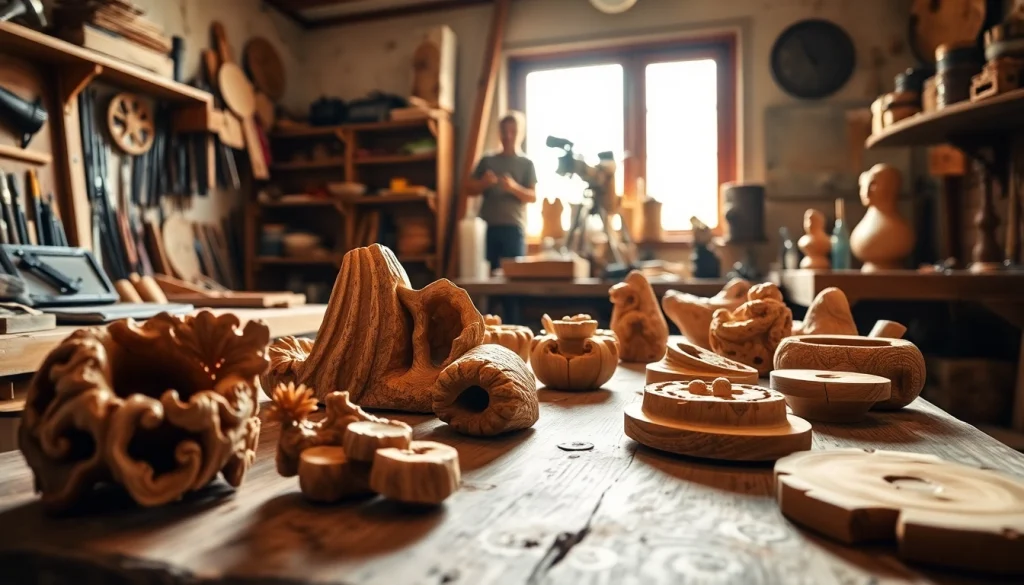Introduction to Olive Wood Carvings
Olive wood carvings, intricately shaped by skilled artisans, hold a unique position in the realm of craftsmanship. Hailing primarily from the fertile lands of the Holy Land, these carvings are steeped in cultural significance and historical richness. They represent not only artistic expression but also a deep-rooted tradition preserved through generations. This article delves into the world of olive wood carvings, examining their characteristics, types, care techniques, and the importance of supporting local artisans. For a deeper appreciation of this craft and collections, explore the exquisite Olive wood carvings available at various art institutions.
What Are Olive Wood Carvings?
Olive wood carvings are art pieces meticulously crafted from the wood of the olive tree, known for its rich grain and natural beauty. The wood varies in color from creamy beige to deep brown, offering natural patterns that add character to every piece. Carving with this durable medium allows artisans to create a range of products, including religious symbols, figurines, and decorative items. Each piece embodies a unique story, whether it represents a Christian figure or a local cultural motif, making every artifact distinct and valuable.
The Cultural Significance of Olive Wood Carvings
Beyond their aesthetic appeal, olive wood carvings carry immense cultural and religious significance. In Christianity, for example, olive wood is often associated with peace and victory. Statues and carvings depicting biblical scenes or saints serve as tangible expressions of faith, reminding believers of spiritual narratives. Additionally, olive trees are considered sacred in many cultures, symbolizing hope and resilience, further elevating the significance of these carvings in religious communities.
History and Traditions of Olive Wood Craftsmanship
The tradition of olive wood carving dates back centuries in the Holy Land. Artisans have honed their skills through generations, often learning techniques passed down from grandparents and parents. Historically, these carvings were used not only for religious purposes but also as trade items, reflecting a blend of artistry and commerce. In contemporary times, the craftsmanship remains alive, allowing artisans to offer both traditional and modern interpretations of olive wood carvings, thereby preserving their cultural heritage while appealing to broader audiences.
Characteristics of Quality Olive Wood Carvings
Identifying Fine Craftsmanship
To appreciate olive wood carvings fully, it’s vital to recognize the elements of quality craftsmanship. Fine carvings exhibit a high level of detail and precision, with smooth finishes and well-defined features. The artisan’s skill is evident in the intricate detailing of facial expressions, textures, and overall form. When assessing quality, one should also look for uniformity in thickness and absence of cracks, which can compromise durability and aesthetic appeal.
Understanding the Olive Wood Grain and Color Variations
One of the most captivating aspects of olive wood carvings is the variety of grains and colors present in the wood. The distinct characteristics arise from the tree’s natural growth patterns, influenced by factors such as soil type and weather conditions. Artisans skillfully select pieces that highlight these differences, ensuring that each carving features unique patterns. A deeper understanding of these variations can enhance appreciation for the artistry involved and the natural beauty of olive wood.
Common Techniques Used in Carving
Artisans employ a range of techniques when working with olive wood, each contributing to the final piece’s uniqueness. Traditional hand-carving involves using simple tools to create shapes and details, emphasizing the artisan’s skill. Some artisans may also use techniques such as whittling or chisel work, carving by hand to intricate designs. Additionally, contemporary methods may incorporate more modern tools while still honoring traditional practices, allowing for innovation within the craft.
Types of Olive Wood Carvings Available
Religious Figures and Symbols
Religious figures and symbols are a significant category of olive wood carvings. These include nativity scenes, crucifixes, and statues of saints, each crafted with reverence and precision. These artifacts not only serve decorative purposes but also play vital roles in religious rituals, helping to convey stories of faith and spirituality. Many collectors and worshippers cherish these pieces for their artistry and the sentiments they evoke, often passing them down as family heirlooms.
Decorative Items and Functional Art
Beyond religious expressions, olive wood offers versatility in creating decorative items and functional art. Bowls, utensils, and furniture pieces made from olive wood showcase intricate designs that draw on the wood’s natural beauty. These items are not only practical but also enhance the aesthetic of any space. Functional art serves as a bridge between utility and beauty, showcasing how craftsmanship can elevate everyday objects into works of art.
Custom and Personalized Carvings
Many artisans offer custom olive wood carvings, allowing individuals to commission pieces that reflect personal significance. Custom carvings can include names, dates, or unique designs tailored to the client’s preferences. This personalization adds emotional value, making these pieces not just decorative items but cherished memories or gifts. Whether for weddings, anniversaries, or other milestones, personalized carvings can celebrate individual stories through artistry.
How to Care for Olive Wood Carvings
Cleaning and Maintenance Tips
To preserve the beauty and longevity of olive wood carvings, proper care is essential. Cleaning should be gentle to avoid damaging the wood’s finish. Using a soft, damp cloth to wipe the surface is usually sufficient. It’s crucial to avoid soaking the wood or using harsh chemicals, as these can strip the natural oils and lead to cracking. Additionally, applying food-safe mineral oil every few months can help maintain the wood’s luster and protect against moisture.
Restoration of Olive Wood Items
Over time, even the most cherished olive wood carvings may show signs of wear. Restoration can breathe new life into older pieces, requiring careful attention and skill. Minor scratches or dullness can often be remedied with a light sanding followed by oiling. However, significant damage may require the expertise of a professional restorer, especially for antiques that need preserving. Understanding when to attempt DIY restoration versus seeking professional help ensures the longevity of these artifacts.
Best Storage Practices to Ensure Longevity
Proper storage of olive wood carvings is vital for their longevity. Ideally, these pieces should be kept in a cool, dry place away from direct sunlight, which can cause fading and warping over time. Utilizing display cases can protect them from dust and physical damage. For small items, consider padded storage boxes that prevent scratches and collisions. Adhering to these storage practices can help maintain both the aesthetic and structural integrity of olive wood carvings for years to come.
Where to Buy Authentic Olive Wood Carvings
Recognizing Authentic Craftsmanship from the Holy Land
When seeking authentic olive wood carvings, it is essential to know how to identify genuine pieces crafted in the Holy Land. Authentic carvings are often marked by the unique grain patterns and art styles unique to the region. Buying directly from local artisans, craft fairs, or certified retailers ensures that the pieces are ethically sourced and support the local community. Verifying the origin of the carvings is critical in acquiring truly authentic artifacts.
Online Retailers and Local Artisans
The growth of e-commerce has made it easier than ever to access olive wood carvings. Numerous online platforms specialize in selling these handcrafted items, often featuring artisans from the Holy Land. Local artisans also frequently sell their creations at markets, fairs, or galleries. Engaging with these local artists provides not only a unique shopping experience but also fosters meaningful connections with the culture and craftsmanship behind the pieces.
Supporting Local Communities through Purchases
Purchasing olive wood carvings does more than simply acquire art; it plays a crucial role in supporting local communities. Many artisans rely on the income from their craft to sustain their livelihoods. By choosing to buy authentic olive wood carvings, consumers help preserve the art form, encourage skill transmission between generations, and support economic stability within these communities. This conscious consumerism imbues each purchase with a deeper meaning, fostering appreciation for both the artwork and its origins.


